canada 加拿大国家概况
加拿大有多大

加拿大有多大加拿大是北美洲最大的国家,位于北美洲的北部,总面积为9.98万平方公里。
它与美国接壤,有大西洋、太平洋和北冰洋的海岸线。
加拿大是一个国土广阔,自然资源丰富的国家,被誉为地球的“后花园”。
加拿大地处北纬41度至83度之间,东西方向跨度约7700公里,南北方向跨度约4600公里,沿海岸线总长度约公里。
加拿大的国土面积中有七成是森林,而且拥有世界上最长的海岸线。
加拿大的地理环境多样,有山脉、平原、湖泊、大河和冰川等自然地貌,其中包括落基山脉、圣劳伦斯河和五大湖等著名地理景观。
加拿大的气候因地域辽阔而多样化。
南部地区属于温带湿润气候,冬季较冷,夏季较热,降雨较多。
北部地区则属于寒带气候,冬季极冷,夏季短暂而凉爽。
加拿大的北极地区受到永久冰雪的覆盖,被誉为北极的极乐园。
加拿大的人口约为3800万人,是世界上人口稀少的国家之一。
加拿大的人口主要分布在南部,其中多伦多、温哥华和蒙特利尔是人口最多的城市。
加拿大是一个多元文化的国家,有来自世界各地的移民,包括欧洲、亚洲、非洲和拉丁美洲等地的人们。
加拿大的经济相对发达,属于高收入国家。
加拿大以其丰富的自然资源而闻名,包括石油、天然气、金属矿产和木材等。
此外,加拿大还拥有先进的制造业和服务业。
加拿大的经济体系被认为是混合经济体系,既有市场经济的特征,也有政府干预的一面。
加拿大的政治制度是议会制民主制度,国家元首是英国女王,同时也是加拿大的国家元首。
政府由总理和内阁组成,由国会选举产生。
加拿大是一个联邦制国家,由10个省和3个地区组成,每个省和地区都有自己的政府。
加拿大是联合国、北约和世界贸易组织等国际组织的成员。
加拿大的教育体系备受推崇,拥有世界一流的大学和研究机构。
加拿大的医疗保健系统也被认为是全球最好之一,为国民提供免费或低成本的医疗服务。
加拿大的文化多元且富有特色,包括英法两种主要文化传统,同时还有大量的原住民文化和移民文化。
加拿大人崇尚自由、平等和多样性,以和谐共处而闻名。
加拿大旅游资源特点与赏析
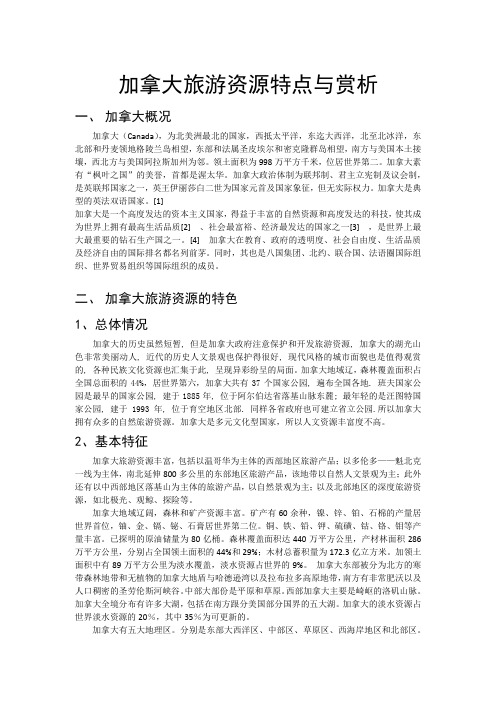
加拿大旅游资源特点与赏析一、加拿大概况加拿大(Canada),为北美洲最北的国家,西抵太平洋,东迄大西洋,北至北冰洋,东北部和丹麦领地格陵兰岛相望,东部和法属圣皮埃尔和密克隆群岛相望,南方与美国本土接壤,西北方与美国阿拉斯加州为邻。
领土面积为998万平方千米,位居世界第二。
加拿大素有“枫叶之国”的美誉,首都是渥太华。
加拿大政治体制为联邦制、君主立宪制及议会制,是英联邦国家之一,英王伊丽莎白二世为国家元首及国家象征,但无实际权力。
加拿大是典型的英法双语国家。
[1]加拿大是一个高度发达的资本主义国家,得益于丰富的自然资源和高度发达的科技,使其成为世界上拥有最高生活品质[2] 、社会最富裕、经济最发达的国家之一[3] ,是世界上最大最重要的钻石生产国之一。
[4] 加拿大在教育、政府的透明度、社会自由度、生活品质及经济自由的国际排名都名列前茅。
同时,其也是八国集团、北约、联合国、法语圈国际组织、世界贸易组织等国际组织的成员。
二、加拿大旅游资源的特色1、总体情况加拿大的历史虽然短暂, 但是加拿大政府注意保护和开发旅游资源, 加拿大的湖光山色非常美丽动人, 近代的历史人文景观也保护得很好, 现代风格的城市面貌也是值得观赏的, 各种民族文化资源也汇集于此, 呈现异彩纷呈的局面。
加拿大地域辽,森林覆盖面积占全国总面积的44%,居世界第六,加拿大共有37个国家公园, 遍布全国各地. 班夫国家公园是最早的国家公园, 建于1885年, 位于阿尔伯达省落基山脉东麓; 最年轻的是汪图特国家公园, 建于1993年, 位于育空地区北部. 同样各省政府也可建立省立公园.所以加拿大拥有众多的自然旅游资源。
加拿大是多元文化型国家,所以人文资源丰富度不高。
2、基本特征加拿大旅游资源丰富,包括以温哥华为主体的西部地区旅游产品;以多伦多——魁北克一线为主体,南北延伸800多公里的东部地区旅游产品,该地带以自然人文景观为主;此外还有以中西部地区落基山为主体的旅游产品,以自然景观为主;以及北部地区的深度旅游资源,如北极光、观鲸、探险等。
Canada有多大?
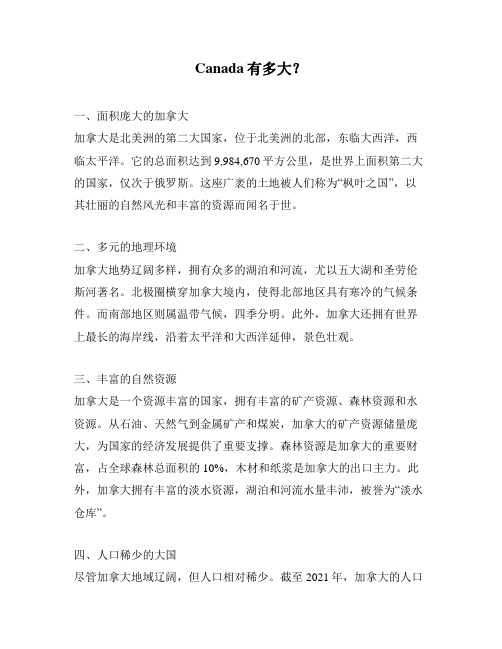
Canada有多大?一、面积庞大的加拿大加拿大是北美洲的第二大国家,位于北美洲的北部,东临大西洋,西临太平洋。
它的总面积达到9,984,670平方公里,是世界上面积第二大的国家,仅次于俄罗斯。
这座广袤的土地被人们称为“枫叶之国”,以其壮丽的自然风光和丰富的资源而闻名于世。
二、多元的地理环境加拿大地势辽阔多样,拥有众多的湖泊和河流,尤以五大湖和圣劳伦斯河著名。
北极圈横穿加拿大境内,使得北部地区具有寒冷的气候条件。
而南部地区则属温带气候,四季分明。
此外,加拿大还拥有世界上最长的海岸线,沿着太平洋和大西洋延伸,景色壮观。
三、丰富的自然资源加拿大是一个资源丰富的国家,拥有丰富的矿产资源、森林资源和水资源。
从石油、天然气到金属矿产和煤炭,加拿大的矿产资源储量庞大,为国家的经济发展提供了重要支撑。
森林资源是加拿大的重要财富,占全球森林总面积的10%,木材和纸浆是加拿大的出口主力。
此外,加拿大拥有丰富的淡水资源,湖泊和河流水量丰沛,被誉为“淡水仓库”。
四、人口稀少的大国尽管加拿大地域辽阔,但人口相对稀少。
截至2021年,加拿大的人口约为3800万人,人口密度较低。
由于国土广袤,人口分布较为分散,大多数人口集中在南部城市和沿海地区。
多元的人口构成使得加拿大成为一个移民大国,吸引了来自全球各个角落的移民慕名前往。
五、先进的经济体系加拿大拥有发达的市场经济体系,是世界上最富裕的国家之一。
其经济以服务业和制造业为主导,金融、能源和科技等行业也发展迅速。
加拿大是世界第十大经济体,与美国等发达国家保持着紧密的经济联系。
稳定的经济环境和优质的教育资源吸引了全球范围内的商业和人才投资。
结语:加拿大作为世界上面积第二大的国家,拥有广袤的土地、多样的地理环境和丰富的自然资源。
它的人口稀少但经济发达,吸引了全球的目光。
了解和探索加拿大的巨大魅力,对于我们对于这个世界的认知将会有重要的意义。
加拿大简介

加拿大简介加拿大是位于北美洲的一个国家,拥有广阔的领土和丰富的自然资源。
它是世界上面积第二大的国家,仅次于俄罗斯,人口约3800万。
加拿大以其壮丽的自然风光、多元文化和友好的人民而闻名于世。
本文将对加拿大的历史、文化、经济、自然景观以及未来展望进行详细介绍。
一、历史概览加拿大的历史可以追溯到数千年前,当时这里居住着印第安人和因纽特人。
16世纪,法国和英国的探险家开始抵达加拿大,并建立了殖民地。
经过长时间的争夺,英国最终在18世纪获得了对加拿大的控制权,并形成了现今的加拿大。
在19世纪和20世纪,加拿大经历了工业化、城市化和移民潮等重要的社会变革。
同时,加拿大积极参与国际事务,成为了一个独立且重要的国家。
二、文化特色加拿大是一个多元文化的国家,拥有来自世界各地的移民和原住民社区。
这种多元文化使得加拿大的文化景观丰富多彩。
加拿大有两种官方语言:英语和法语,这反映了其历史上的英法殖民背景。
此外,加拿大的文化还受到原住民文化、欧洲文化和其他移民文化的影响。
在音乐、电影、文学和艺术等领域,加拿大都有着独特的贡献和成就。
三、经济发展加拿大是世界上最发达的国家之一,拥有稳定的经济基础和丰富的自然资源。
其经济主要由服务业、制造业和资源产业驱动。
加拿大是世界上最大的石油和天然气生产国之一,同时也是重要的木材、矿产和农产品出口国。
此外,加拿大在科技、金融和旅游业等领域也有着显著的发展。
加拿大政府致力于推动创新、可持续发展和国际贸易,以促进经济的持续增长和繁荣。
四、自然景观加拿大拥有壮丽而多样的自然景观,从广袤的森林和草原到雄伟的山脉和湖泊,再到壮观的冰川和海岸线,每一处都充满了自然的魅力。
加拿大最著名的自然景观之一是落基山脉,它横跨多个省份,拥有高峰、深谷和壮丽的冰川。
此外,加拿大还有大量的国家公园和保护区,这些地方保护着丰富的野生动植物和自然生态系统。
五、未来展望展望未来,加拿大面临着许多挑战和机遇。
随着全球化的加速和科技的不断发展,加拿大需要继续推动经济创新和发展高科技产业,以适应不断变化的世界经济格局。
加拿大资料

加拿大(Canada),为北美洲最北的国家,西抵太平洋,东迄大西洋,北至北冰洋,东北部和丹麦领地格陵兰岛相望,东部和法属圣皮埃尔和密克隆群岛相望,南方与美国本土接壤,西北方与美国阿拉斯加州为邻。
领土面积为998万平方千米,位居世界第二。
加拿大因受西风影响,加大部分地区属大陆性温带针叶林气候。
加拿大素有“枫叶之国”的美誉,首都是渥太华。
加拿大政治体制为联邦制、君主立宪制及议会制,是英联邦国家之一,英王伊丽莎白二世为国家元首及国家象征,但无实际权力。
加拿大是典型的英法双语国家。
加拿大在教育、政府的透明度、社会自由度、生活品质及经济自由的国际排名都名列前茅。
同时,其也是八国集团、北约、联合国、法语圈国际组织、世界贸易组织等国际组织的成员。
2015年10月19日,加拿大自由党在大选中以压倒性优势击败执政的保守党,成为众议院第一大党,党魁贾斯廷·特鲁多出任加拿大新一届总理。
2016年1月20日,全球最佳国家排名出炉,加拿大排名第二。
主词条:加拿大历史[2]加拿大原来是印第安人与因纽特人的居住地。
16世纪,法国人梦想发现并统治更多的疆域,扩展他们的贸易范围,并让世界各国信奉他们的信仰。
1535年,当时的法国国王弗朗索瓦一世命令航海家杰克斯·卡蒂埃尔(Jacques Kartier)去探寻“新世界”,以求找到一条通往印度的航道。
卡蒂埃尔首次探险来到了圣劳伦斯海湾。
这时他并不知道会在这里发现什么,但他希望这是大洋的一个分支,并是他通往远东征程的必经之路。
于是他沿圣劳伦斯河逆流而上。
然而他并没有到达所期盼的亚洲,却来到了魁北克(Québec),当地的印第安人称它“Stadakona”。
两名印第安青年告诉了Jacques Cartier通往“kanata”的路线,他们当时指Canada,这个名字一直沿用到17世纪初期。
Canada一词源于印第安语的“Canada”,意为“群落”或“村庄”。
canada是哪个国家
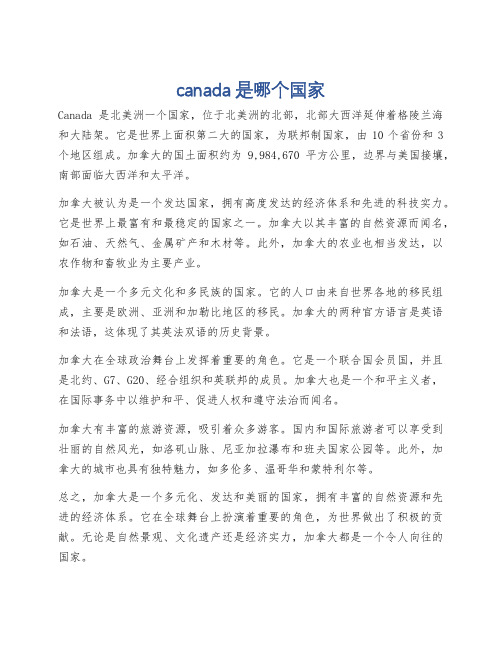
canada是哪个国家
Canada是北美洲一个国家,位于北美洲的北部,北部大西洋延伸着格陵兰海和大陆架。
它是世界上面积第二大的国家,为联邦制国家,由10个省份和3个地区组成。
加拿大的国土面积约为9,984,670平方公里,边界与美国接壤,南部面临大西洋和太平洋。
加拿大被认为是一个发达国家,拥有高度发达的经济体系和先进的科技实力。
它是世界上最富有和最稳定的国家之一。
加拿大以其丰富的自然资源而闻名,如石油、天然气、金属矿产和木材等。
此外,加拿大的农业也相当发达,以农作物和畜牧业为主要产业。
加拿大是一个多元文化和多民族的国家。
它的人口由来自世界各地的移民组成,主要是欧洲、亚洲和加勒比地区的移民。
加拿大的两种官方语言是英语和法语,这体现了其英法双语的历史背景。
加拿大在全球政治舞台上发挥着重要的角色。
它是一个联合国会员国,并且是北约、G7、G20、经合组织和英联邦的成员。
加拿大也是一个和平主义者,在国际事务中以维护和平、促进人权和遵守法治而闻名。
加拿大有丰富的旅游资源,吸引着众多游客。
国内和国际旅游者可以享受到壮丽的自然风光,如洛矶山脉、尼亚加拉瀑布和班夫国家公园等。
此外,加拿大的城市也具有独特魅力,如多伦多、温哥华和蒙特利尔等。
总之,加拿大是一个多元化、发达和美丽的国家,拥有丰富的自然资源和先进的经济体系。
它在全球舞台上扮演着重要的角色,为世界做出了积极的贡献。
无论是自然景观、文化遗产还是经济实力,加拿大都是一个令人向往的国家。
加拿大国家概况(留学知识)
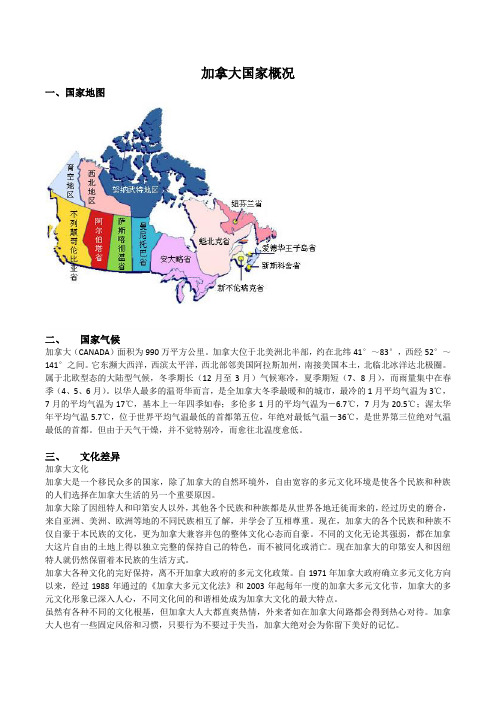
加拿大国家概况一、国家地图二、国家气候加拿大(CANADA)面积为990万平方公里。
加拿大位于北美洲北半部,约在北纬41°~83°,西经52°~141°之间。
它东濒大西洋,西滨太平洋,西北部邻美国阿拉斯加州,南接美国本土,北临北冰洋达北极圈。
属于北欧型态的大陆型气候,冬季期长(12月至3月)气候寒冷,夏季期短(7、8月),而雨量集中在春季(4、5、6月)。
以华人最多的温哥华而言,是全加拿大冬季最暖和的城市,最冷的1月平均气温为3℃,7月的平均气温为17℃,基本上一年四季如春;多伦多1月的平均气温为-6.7℃,7月为20.5℃;渥太华年平均气温5.7℃,位于世界平均气温最低的首都第五位,年绝对最低气温-36℃,是世界第三位绝对气温最低的首都。
但由于天气干燥,并不觉特别冷,而愈往北温度愈低。
三、文化差异加拿大文化加拿大是一个移民众多的国家,除了加拿大的自然环境外,自由宽容的多元文化环境是使各个民族和种族的人们选择在加拿大生活的另一个重要原因。
加拿大除了因纽特人和印第安人以外,其他各个民族和种族都是从世界各地迁徙而来的,经过历史的磨合,来自亚洲、美洲、欧洲等地的不同民族相互了解,并学会了互相尊重。
现在,加拿大的各个民族和种族不仅自豪于本民族的文化,更为加拿大兼容并包的整体文化心态而自豪。
不同的文化无论其强弱,都在加拿大这片自由的土地上得以独立完整的保持自己的特色,而不被同化或消亡。
现在加拿大的印第安人和因纽特人就仍然保留着本民族的生活方式。
加拿大各种文化的完好保持,离不开加拿大政府的多元文化政策。
自1971年加拿大政府确立多元文化方向以来,经过1988年通过的《加拿大多元文化法》和2003年起每年一度的加拿大多元文化节,加拿大的多元文化形象已深入人心,不同文化间的和谐相处成为加拿大文化的最大特点。
虽然有各种不同的文化根基,但加拿大人大都直爽热情,外来者如在加拿大问路都会得到热心对待。
加拿大基本介绍范文
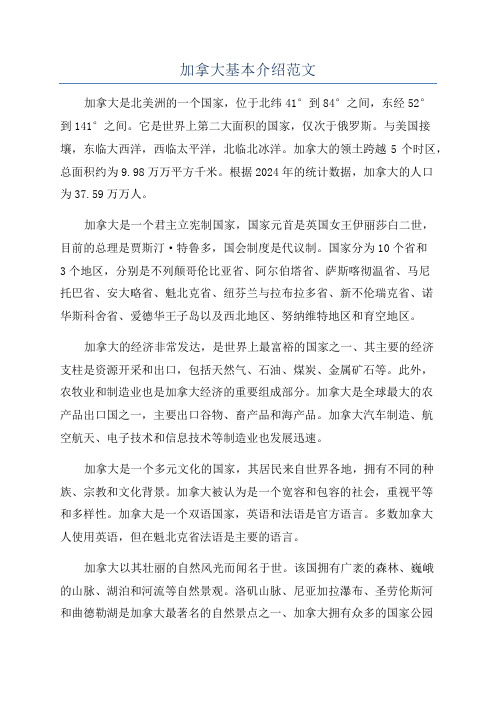
加拿大基本介绍范文加拿大是北美洲的一个国家,位于北纬41°到84°之间,东经52°到141°之间。
它是世界上第二大面积的国家,仅次于俄罗斯。
与美国接壤,东临大西洋,西临太平洋,北临北冰洋。
加拿大的领土跨越5个时区,总面积约为9.98万万平方千米。
根据2024年的统计数据,加拿大的人口为37.59万万人。
加拿大是一个君主立宪制国家,国家元首是英国女王伊丽莎白二世,目前的总理是贾斯汀·特鲁多,国会制度是代议制。
国家分为10个省和3个地区,分别是不列颠哥伦比亚省、阿尔伯塔省、萨斯喀彻温省、马尼托巴省、安大略省、魁北克省、纽芬兰与拉布拉多省、新不伦瑞克省、诺华斯科舍省、爱德华王子岛以及西北地区、努纳维特地区和育空地区。
加拿大的经济非常发达,是世界上最富裕的国家之一、其主要的经济支柱是资源开采和出口,包括天然气、石油、煤炭、金属矿石等。
此外,农牧业和制造业也是加拿大经济的重要组成部分。
加拿大是全球最大的农产品出口国之一,主要出口谷物、畜产品和海产品。
加拿大汽车制造、航空航天、电子技术和信息技术等制造业也发展迅速。
加拿大是一个多元文化的国家,其居民来自世界各地,拥有不同的种族、宗教和文化背景。
加拿大被认为是一个宽容和包容的社会,重视平等和多样性。
加拿大是一个双语国家,英语和法语是官方语言。
多数加拿大人使用英语,但在魁北克省法语是主要的语言。
加拿大以其壮丽的自然风光而闻名于世。
该国拥有广袤的森林、巍峨的山脉、湖泊和河流等自然景观。
洛矶山脉、尼亚加拉瀑布、圣劳伦斯河和曲德勒湖是加拿大最著名的自然景点之一、加拿大拥有众多的国家公园和保护区,其中包括洛矶山脉国家公园、万锦湖国家公园和贾斯珀国家公园。
这些地方吸引着大量的游客,提供了徒步旅行、滑雪、钓鱼等户外活动的机会。
加拿大还以其高质量的教育系统闻名于世。
加拿大的大学和学院在全球范围内享有很高的声誉。
该国的教育体系注重学术和职业结合,培养出高素质的毕业生。
加拿大有多大

加拿大有多大加拿大是北美洲最大的国家之一,位于北纬41°00′至83°00′、西经52°00′至141°00′之间。
其国土面积约为9.98万55平方公里,是世界第二大国家。
加拿大与美国接壤,北部濒临北冰洋,东部和西部则被大西洋和太平洋环绕。
加拿大的地势起伏不平,有许多山脉和河流。
加拿大的地理特点非常丰富多样。
从东部的大西洋省份到西部的落基山脉,再到北部的冻土地带,加拿大拥有壮丽的自然景观。
尤其是落基山脉,其绵延数千公里,拥有壮观的山峰、湖泊和冰川,吸引了无数游客和登山者。
加拿大还拥有丰富的自然资源,如木材、矿产和水力资源,对其经济发展起到了重要的推动作用。
加拿大的气候因其广袤的土地而多种多样。
南部地区与美国接壤的地区气候较为温暖,四季分明;而北部的地区则气候寒冷,冬季漫长且严寒,夏季短暂而凉爽。
加拿大也是北极圈内的国家,拥有独特的极地气候,使该国在科研和生物多样性方面具有独特的优势。
加拿大的人口约为3800万人,是世界上人口较少的国家之一。
加拿大人民以其友善、包容和多元文化而闻名于世。
加拿大是一个移民国家,吸引了来自世界各地的移民。
多元文化是加拿大社会的一大特点,许多移民和少数族裔在这里繁荣发展,并为加拿大文化的多样性做出了重要贡献。
加拿大是一个议会制国家,属于英联邦国家。
国家元首是英国女王伊丽莎白二世,而加拿大的首相则是由国会选举产生的。
加拿大实行联邦制,由10个省份和3个地区组成。
各个省份和地区都有一定的自治权,同时也享有共同的国家政权。
加拿大的经济以其自然资源为基础,特别是矿产和能源资源。
石油、天然气、钢铁、木材和渔业对加拿大经济做出了重要贡献。
加拿大是世界主要国家之一,其经济实力和人均收入在全球范围内也居于较高水平。
加拿大有着完善的教育体系和医疗体系,为国民提供了高质量的教育和医疗服务。
此外,加拿大也非常注重环境保护和可持续发展,努力保护其独特的自然景观和生态系统。
加拿大介绍

加拿大介绍加拿大是一个位于北美洲的英联邦国家,是世界上面积第二大的国家。
它与北美大陆的其他国家相比,加拿大人口较少,但是拥有广阔的土地和丰富的自然资源。
以下是对加拿大的介绍。
1. 历史与政治:加拿大的历史可以追溯到几千年前的原住民部落,后来被欧洲的探险家和殖民者所控制。
在1867年,加拿大成为英国的自治领,直到1982年完全独立。
加拿大现在是一个联邦制国家,由10个省和3个地区组成,首都是渥太华。
2. 地理与自然景观:加拿大是一个地理上多样化的国家,有广袤的草原、崇山峻岭、森林和湖泊。
洛矶山脉位于加拿大西部,是长达4800公里的美丽山脉。
五大湖,即安大略湖、休伦湖、密歇根湖、伊利湖和苏必利尔湖位于加拿大和美国的边界上,是世界上最大的淡水湖群。
3. 经济与产业:加拿大是世界上最发达的国家之一,拥有高度发达的经济体系。
该国主要产业包括石油和天然气、采矿、林业、农业和制造业。
加拿大是石油和天然气的主要出口国之一,拥有世界上最大的石油砂岩储量。
此外,加拿大也以其高质量的木材和农产品闻名。
4. 文化与人民:加拿大是一个多元文化的国家,拥有来自世界各地的移民。
在加拿大,许多不同的文化、宗教和语言共存。
英语和法语是加拿大的官方语言,多数人以英语为母语。
加拿大人以友善、慷慨和乐于助人著称。
5. 教育与医疗:加拿大拥有世界上一些最好的教育和医疗系统。
加拿大的大学和学院享有很高的声誉,吸引着许多国际学生。
该国也提供免费的公共医疗保健服务,使人们能够获得高质量的医疗照顾。
6. 旅游与景点:加拿大有许多令人惊叹的旅游景点,吸引着世界各地的游客。
落基山脉是加拿大最受欢迎的旅游景点之一,提供了壮丽的自然风景和丰富的户外活动。
尼亚加拉瀑布是世界上最著名的瀑布之一,位于加拿大和美国的边境。
温哥华是加拿大西海岸的城市,被认为是世界上最适宜居住的城市之一。
总结:加拿大是一个多元文化、资源丰富且自然美景壮观的国家。
它的历史、政治、地理、经济和文化都使加拿大成为一个引人入胜的地方。
加拿大简介

加拿大简介加拿大简介加拿大是位于北美洲的国家,是全球面积第二大的国家,仅次于俄罗斯。
加拿大横跨大西洋与太平洋,北接北冰洋,东临大西洋,西抱太平洋。
加拿大的邻国包括美国,北部与阿拉斯加相邻,西南边界隔着五大湖与美国接壤。
加拿大是一个联邦制国家,由十个省份和三个地区组成。
首都是渥太华,最大城市是多伦多。
加拿大的官方语言为英语和法语,是世界上仅有的两个官方语言都为主要语言的国家之一。
加拿大拥有丰富的自然资源,包括森林、矿产、水资源等。
其土地面积广阔,气候多样,拥有着壮观的自然景观,如落基山脉、尼亚加拉大瀑布等。
加拿大拥有众多国家公园和自然保护区,为世界上最受欢迎的旅游目的地之一。
加拿大是一个高度发达的工业化国家,工业部门主要包括制造业、能源和矿业、服务业等。
加拿大是世界上最大的铜和锌生产国之一,也是世界上最大的木材和纸浆出口国之一。
此外,加拿大也是全球领先的电影和电视制作国家。
加拿大以其开放和多元的社会而闻名,素有“全球移民的首选目的地”之称。
加拿大的移民政策非常宽松,鼓励并接纳来自世界各地的移民。
多元文化在加拿大社会中扮演着重要的角色,不同的文化背景在这里和谐共存。
加拿大在教育和医疗领域也取得了很大成就。
加拿大拥有一流的教育体系,各级教育机构为学生提供多样化的学习机会。
加拿大的医疗系统被公认为世界上最佳之一,每个公民都可以享受到高质量的医疗保健服务。
加拿大在国际事务中发挥着重要的作用。
加拿大是联合国创始会员国之一,是北约、七国集团等国际组织的成员。
加拿大积极参与国际援助,是发展援助的主要供应国之一。
总之,加拿大是一个拥有丰富资源、多元文化和优质生活的国家。
其开放包容的社会和良好的福利制度吸引着全球各地的人们。
无论是美丽的自然景观还是发达的经济,加拿大都是一个值得探索和了解的国家。
加拿大有多大
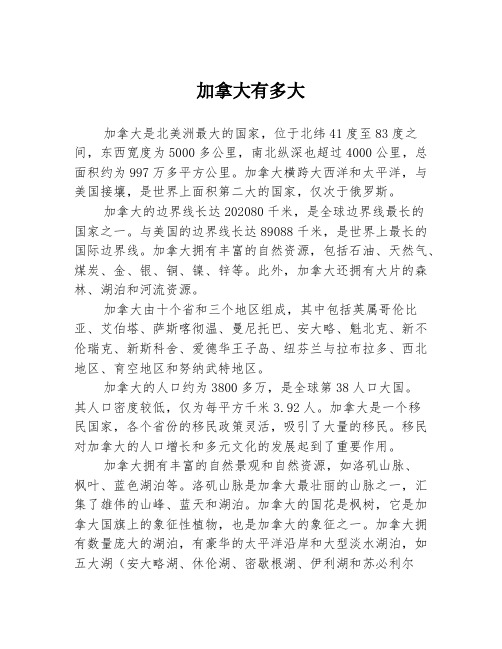
加拿大有多大加拿大是北美洲最大的国家,位于北纬41度至83度之间,东西宽度为5000多公里,南北纵深也超过4000公里,总面积约为997万多平方公里。
加拿大横跨大西洋和太平洋,与美国接壤,是世界上面积第二大的国家,仅次于俄罗斯。
加拿大的边界线长达202080千米,是全球边界线最长的国家之一。
与美国的边界线长达89088千米,是世界上最长的国际边界线。
加拿大拥有丰富的自然资源,包括石油、天然气、煤炭、金、银、铜、镍、锌等。
此外,加拿大还拥有大片的森林、湖泊和河流资源。
加拿大由十个省和三个地区组成,其中包括英属哥伦比亚、艾伯塔、萨斯喀彻温、曼尼托巴、安大略、魁北克、新不伦瑞克、新斯科舍、爱德华王子岛、纽芬兰与拉布拉多、西北地区、育空地区和努纳武特地区。
加拿大的人口约为3800多万,是全球第38人口大国。
其人口密度较低,仅为每平方千米3.92人。
加拿大是一个移民国家,各个省份的移民政策灵活,吸引了大量的移民。
移民对加拿大的人口增长和多元文化的发展起到了重要作用。
加拿大拥有丰富的自然景观和自然资源,如洛矶山脉、枫叶、蓝色湖泊等。
洛矶山脉是加拿大最壮丽的山脉之一,汇集了雄伟的山峰、蓝天和湖泊。
加拿大的国花是枫树,它是加拿大国旗上的象征性植物,也是加拿大的象征之一。
加拿大拥有数量庞大的湖泊,有豪华的太平洋沿岸和大型淡水湖泊,如五大湖(安大略湖、休伦湖、密歇根湖、伊利湖和苏必利尔湖)。
加拿大的气候类型多样,主要分为三个区域:南部地区的温带气候、北部地区的极地气候和西北地区的亚北极气候。
南部地区的气候温和,夏季温暖潮湿,冬季湿冷,春秋温差较大。
北部地区的气候极端,冬季寒冷漫长,夏季短暂而凉爽。
西北地区气候严寒,但夏季温度较高。
加拿大的经济发展水平较高,是世界上最富裕的国家之一。
加拿大的主要经济领域包括制造业、能源、金融、旅游和科技。
加拿大是全球主要能源供应国之一,石油和天然气产量丰富。
加拿大还拥有丰富的水力资源,是全球最大的水力发电国家之一。
加拿大介绍

加拿大介绍加拿大(Canada)位于北美洲北部,是世界上国土面积第二大的国家,仅次于俄罗斯。
加拿大东临大西洋,西濒太平洋,北接北冰洋,面积达到9.98万平方公里,国土辽阔,自然资源丰富。
其北部地区被冰川覆盖,南部则是广袤的森林、湖泊和高山。
作为联邦立宪君主制国家,加拿大是一个现代化、多元文化的国家,同时也是经济发达和宜居的国家。
加拿大是一个多元文化的国家,如同大熔炉一般融合了来自世界各地的不同文化群体。
英语和法语是加拿大的官方语言,双语并存。
加拿大的宪法保障了宗教自由和多元文化,并且国家对于少数族裔和移民群体的融入和保护非常重视。
这使得加拿大成为一个包容和友善的社会,吸引了大量的移民。
加拿大的教育体系也非常发达,被认为是世界上最好的教育体系之一。
加拿大的教育注重培养学生的创造力和批判思维能力,鼓励学生自主学习、自由探索。
加拿大拥有许多世界知名的大学和研究机构,如多伦多大学、麦吉尔大学和渥太华大学等。
这些学府在全球范围内享有很高的声誉,并且吸引了许多国际学生前来留学。
加拿大的经济也十分发达,是世界上最富有的国家之一。
加拿大以自然资源开发和制造业为主要支柱产业。
加拿大拥有丰富的石油、天然气和矿产资源,是世界上主要的石油和天然气出口国之一。
此外,加拿大的农业也非常发达,主要生产小麦、玉米、大豆、糖和牛奶等农产品。
加拿大还是世界上最大的木材产品出口国之一,森林资源十分丰富。
加拿大的制造业也非常发达,主要生产汽车、航空航天器材、电子产品和医疗器械等产品。
加拿大的旅游业也十分发达,每年吸引了大量的国内外游客。
加拿大的自然风光非常壮丽,有着世界上最美丽的国家公园之一——洛矶山脉国家公园。
这里有壮丽的冰川、湖泊和高山,吸引着许多登山者和户外爱好者。
尼亚加拉大瀑布是世界闻名的旅游景点之一,每年吸引了数百万游客。
此外,多伦多市和温哥华市也是加拿大最受欢迎的旅游城市之一,拥有丰富的文化和娱乐设施。
总之,加拿大是一个多元文化、宜居和发达的国家。
加拿大有多大

加拿大有多大加拿大是北美洲的一个国家,位于北美大陆的北部,是世界上面积第二大的国家。
它东临大西洋,西临太平洋,北濒北冰洋,与美国隔着边界线相望。
加拿大的面积约为9,984,670平方公里,占地球陆地总面积的6.7%。
它的边界线长度为202,080公里,是世界上最长的边界线。
加拿大的地势较为平坦,主要地形为平原和高原。
该国拥有丰富的自然资源,包括石油、天然气、铁矿石、锌、铜等矿产资源,以及丰富的森林资源。
加拿大也以其广袤的湖泊和河流而闻名,其中包括五大湖(苏必利尔湖、休伦湖、密歇根湖、伊利湖和安大略湖)和长江。
加拿大的气候多样,从寒冷的北极气候到温带湿润气候,各地区的气候因地理位置和海洋影响因素而不同。
加拿大的冬季一般较为寒冷,夏季则相对温暖。
东部和西北部地区的冬季气温可下降到零下30摄氏度甚至更低,而南部地区的夏季气温可达到30摄氏度以上。
加拿大拥有丰富的生物多样性,包括许多独特的动植物物种。
其中以北极熊、驼鹿、鲑鱼、麋鹿和蓝鲸等著名。
此外,加拿大的国土还包括许多岛屿,其中最大的包括维多利亚岛和纽芬兰岛。
加拿大是一个多元文化的国家,其人口由各种族和文化背景的人组成。
主要的民族包括英国后裔、法国后裔、苏格兰后裔、爱尔兰后裔、中国后裔、印度后裔和阿拉伯后裔等。
由于不同民族和文化的影响,加拿大的文化非常多样化。
除了英语和法语,加拿大还有多种其他的官方语言,如西班牙语、德语、意大利语和华语等。
加拿大是一个高度发达的国家,拥有先进的教育系统和医疗保障体系。
该国的经济以服务业为主,包括金融、旅游、科技和娱乐等领域。
加拿大也是世界上最安全和宜居的国家之一,拥有高质量的生活。
总之,加拿大是一个拥有广阔面积、丰富资源和多元文化的国家。
它的自然风光和生物多样性使其成为一个旅游热点,而其发达的经济和高品质的生活条件使其成为一个理想的居住地。
加拿大在世界上扮演着重要的角色,为全球和平与繁荣做出了积极的贡献。
can是哪个国家的简称
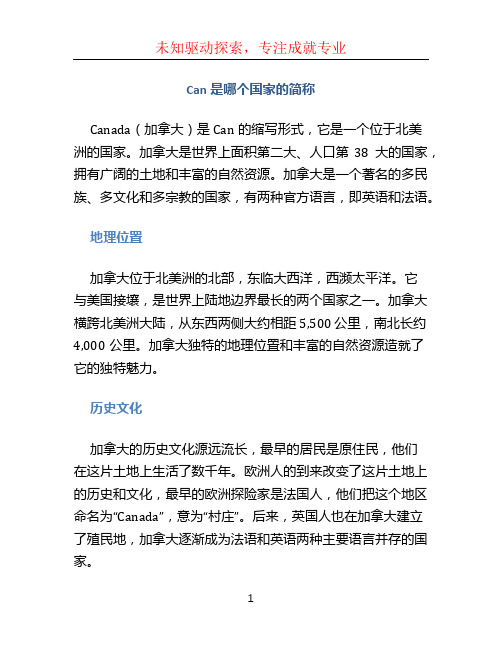
Can是哪个国家的简称Canada(加拿大)是Can的缩写形式,它是一个位于北美洲的国家。
加拿大是世界上面积第二大、人口第38大的国家,拥有广阔的土地和丰富的自然资源。
加拿大是一个著名的多民族、多文化和多宗教的国家,有两种官方语言,即英语和法语。
地理位置加拿大位于北美洲的北部,东临大西洋,西濒太平洋。
它与美国接壤,是世界上陆地边界最长的两个国家之一。
加拿大横跨北美洲大陆,从东西两侧大约相距5,500 公里,南北长约4,000公里。
加拿大独特的地理位置和丰富的自然资源造就了它的独特魅力。
历史文化加拿大的历史文化源远流长,最早的居民是原住民,他们在这片土地上生活了数千年。
欧洲人的到来改变了这片土地上的历史和文化,最早的欧洲探险家是法国人,他们把这个地区命名为“Canada”,意为“村庄”。
后来,英国人也在加拿大建立了殖民地,加拿大逐渐成为法语和英语两种主要语言并存的国家。
加拿大以其多元文化而闻名于世。
它是一个容纳着不同民族、宗教和文化的国家。
加拿大政府致力于保护和促进各种文化的发展,鼓励各个社区保持自己的文化特色。
加拿大的文化遗产包括原住民的传统、英国和法国的殖民历史、以及移民群体的贡献。
政治体制加拿大是一个君主立宪制国家,元首是英国女王伊丽莎白二世。
加拿大的政府体制由联邦、省和地方三个层级组成。
联邦政府负责国家事务,各省有相对自治的权力,地方政府负责本地区的事务。
联邦政府由总理领导,总理是在国会选举中获得最多席位的政党的党魁。
加拿大的国会由众议院和参议院组成。
众议院的议员由全国各地选举产生,参议院的议员由总理任命。
经济发展加拿大是世界上最发达的国家之一,其经济以多样性和稳定性而闻名。
主要经济活动包括能源、制造业、金融和服务业。
加拿大拥有丰富的天然资源,包括石油、天然气、木材和矿产等。
这些资源的开采和加工为加拿大提供了巨大的经济收入。
加拿大是全球贸易的重要角色之一,其与美国之间的贸易往来尤为重要。
加拿大与世界各地建立了广泛的贸易伙伴关系,包括欧盟、中国和墨西哥等国家和地区。
3一5句介绍加拿大的作文
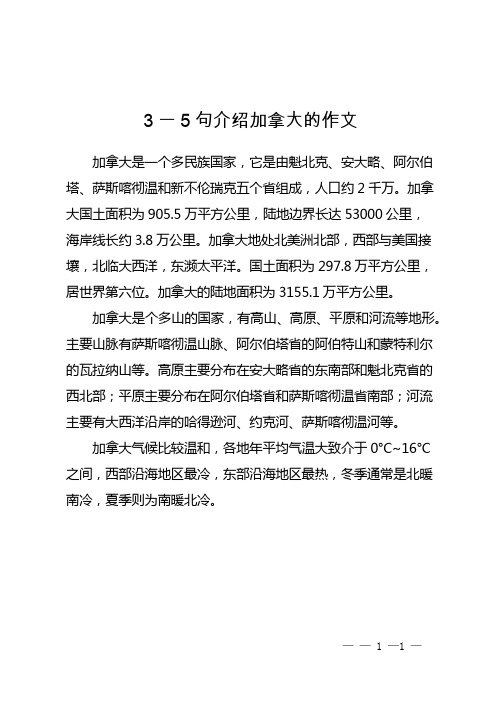
3一5句介绍加拿大的作文
加拿大是一个多民族国家,它是由魁北克、安大略、阿尔伯塔、萨斯喀彻温和新不伦瑞克五个省组成,人口约2千万。
加拿大国土面积为905.5万平方公里,陆地边界长达53000公里,
海岸线长约3.8万公里。
加拿大地处北美洲北部,西部与美国接壤,北临大西洋,东濒太平洋。
国土面积为297.8万平方公里,居世界第六位。
加拿大的陆地面积为3155.1万平方公里。
加拿大是个多山的国家,有高山、高原、平原和河流等地形。
主要山脉有萨斯喀彻温山脉、阿尔伯塔省的阿伯特山和蒙特利尔的瓦拉纳山等。
高原主要分布在安大略省的东南部和魁北克省的西北部;平原主要分布在阿尔伯塔省和萨斯喀彻温省南部;河流主要有大西洋沿岸的哈得逊河、约克河、萨斯喀彻温河等。
加拿大气候比较温和,各地年平均气温大致介于0°C~16°C 之间,西部沿海地区最冷,东部沿海地区最热,冬季通常是北暖南冷,夏季则为南暖北冷。
—— 1 —1 —。
加拿大人文地理简介资料

加拿大人文地理简介资料加拿大位于北美洲,是世界上面积第二大的国家,仅次于俄罗斯。
加拿大与美国接壤,东临大西洋,西濒太平洋,北滨北冰洋,国土广袤,自然风光优美壮观,人文地理特点丰富多样。
一、地理概况加拿大地理位置独特,边境线长且复杂,总面积达到9.98万平方公里,拥有10个省和3个地区。
国家南北纵深广达4770公里,东西宽度也达5500公里。
由于广袤辽阔的地理条件,加拿大拥有丰富的自然资源,包括矿产、森林、水力资源等。
二、地形地势加拿大的地形地势多样,在该国东部沿海是一片广阔的低地,西部则有较高的山脉。
著名的洛矶山脉经过西部的不列颠哥伦比亚省,在这里可以看到壮丽的高山和秀丽的湖泊。
位于科纳希山的哥伦比亚冰原是北美洲最大的非极地冰原,也是世界上最长的冰川。
三、气候特点由于地广人稀,加拿大的气候情况多样。
整体上,加拿大的气候属于温带和寒带气候。
东部和西部沿海地区的气候较为温和,这里气温适中、降雨充沛。
而北部和内陆地区则属于寒带气候,冬季严寒而漫长,夏季短暂但温度适宜。
四、人口和城市加拿大人口稠密程度相对较低,大部分人口集中在南部的城市地区。
多伦多是加拿大最大的城市,也是该国的经济和文化中心。
温哥华则位于西部沿海,被誉为世界上最宜居的城市之一。
此外,渥太华作为加拿大的首都,还有蒙特利尔、卡尔加里等城市也都发挥着重要的作用。
五、文化特点加拿大是一个多元文化的国家,拥有丰富多样的文化传统和人文景观。
加拿大社会对不同族裔的接纳度较高,鼓励不同文化之间的交流与融合。
加拿大的文化活动也非常丰富多样,例如多伦多国际电影节、温哥华艺术画廊等,吸引了许多国内外游客的关注。
六、自然资源加拿大是自然资源丰富的国家,拥有世界上最大的林木资源,其森林覆盖率高达42%。
此外,加拿大的水资源也非常丰富,湖泊和河流密布,其中五大湖是全球最大的淡水湖群。
加拿大还拥有丰富的矿产资源,包括石油、天然气、铜、锌等。
总结:加拿大是一个地理风貌多样、资源丰富的国家。
加拿大

国歌:《啊,加拿大》
国树:枫树
二 习俗礼仪
节日庆典 国庆日(独立日):7月1日 维多利亚日:5月24日 休战纪念日(国殇日):11月11日 枫糖节:3月中旬至4月初
1
2 饮食习俗
加拿大人口味偏淡,不喜欢过咸过辣的菜
肴。忌食动物内脏和脚爪,忌食虾酱,鱼露 等有怪味和腥味的食物。爱吃烤制食品。 特色美食:枫糖煎三文鱼,加拿大熏鲑鱼, 象拔蚌刺身等等
加拿大
一 基本国情
1.地理气候 加拿大是北美洲最北的一个国家,面积998 万平方千米,居世界第二位。西临太平洋, 东濒大西洋,北到北冰洋,南方及西北方 与美国接壤,湖泊众多。 加拿大大部分地区属温带大陆性气候,北 部为寒带苔原气候,北极群岛终年严寒。
2.人口和居民
加拿大人口3350.47万。原住民只占人口的
2%,其他98%全部是移民和后代。 官方语言是英语和法语,其中英语是广泛 使用的语言。 加拿大无国教,主要信仰天主教和基督教。
3 国旗.国徽.国歌.国树
国旗:加拿大国旗,又称枫叶旗。两边的红 竖长方形代表太平洋和大西洋,白色正方 形代表加拿大的广阔国土,红枫叶代表全 体加拿大人民。
国徽:图案中间为盾形, 盾面下部为一枝三片枫叶; 上部的四组图案分别为: 三头金色的狮子,一头直 立的红狮,一把竖琴和三 朵百合花,分别象征加拿 大在历史上与英格兰,苏格 兰,爱尔兰和法国之间的 联系。盾徽之上有一头狮 子举着一片红枫叶,既是 加拿大民族的象征。也是 对第一次世界大战期间加 拿大牺牲者的悼念。狮子 之上为一顶金色的王冠, 象征英女王是加拿大国家 元首。
5 维多利亚:秀美宁静,有“花园城市” 之称
6
黄刀:加拿大纬度高,很多地方适宜 观赏极光现象,最佳的观赏地点为黄刀 市
加拿大介绍

加拿大介绍加拿大位于北美洲北部,是世界第二大国家,也是世界上人口密度较低的国家之一。
加拿大拥有丰富的自然资源和多元文化,被誉为一个安全、友善和宜居的国家。
在这篇文章中,我们将对加拿大的地理、历史、文化和旅游景点进行介绍。
地理:加拿大的地理环境十分多样,包括广袤的北美大陆和数千个岛屿。
加拿大共有10个省和3个地区,人口主要分布在南部沿海地区和大城市。
加拿大有世界上最长的海岸线,同时还拥有众多壮观的自然景观,如洛矶山脉和尼亚加拉大瀑布。
历史:加拿大的历史可以追溯到约1000年前,当时这片土地上有原住民部落居住。
17世纪时,法国和英国开始在这里建立殖民地。
1763年,英国掌握了加拿大的控制权,并建立了不列颠北美省。
在随后的几个世纪中,加拿大持续扩张,并于1867年成立加拿大联邦。
加拿大在20世纪初获得了一定的自治权,成为一个独立的国家。
文化:加拿大是一个多元文化的国家,拥有丰富的文化遗产和多种语言。
加拿大官方语言为英语和法语,但这里还有许多其他语言的使用者。
加拿大的文化受到英国、法国、原住民和其他移民文化的影响。
加拿大人民注重平等和多元,尊重各种文化和宗教信仰,这也使加拿大成为一个宽容和友善的社会。
旅游景点:加拿大拥有许多壮观的旅游景点,吸引着全球游客。
尼亚加拉大瀑布是世界著名的自然奇观之一,每年吸引数百万游客。
洛矶山脉是加拿大西部的著名景点,那里的山峰壮丽宏伟,适合进行登山和滑雪运动。
温哥华岛是一个美丽的海岛,拥有壮观的自然风景和众多户外活动。
此外,多伦多和蒙特利尔等大城市也有许多文化和历史景点,值得一游。
总结:加拿大是一个多元文化、自然丰富的国家,拥有令人惊叹的自然景观和丰富的文化遗产。
这里的人们友善且宽容,使得加拿大成为一个理想的居住和旅游目的地。
无论是在洛矶山脉滑雪,还是在温哥华享受海滩,加拿大都能给您带来难忘的经历。
希望你有机会去加拿大亲身体验这个美丽国家的魅力!。
- 1、下载文档前请自行甄别文档内容的完整性,平台不提供额外的编辑、内容补充、找答案等附加服务。
- 2、"仅部分预览"的文档,不可在线预览部分如存在完整性等问题,可反馈申请退款(可完整预览的文档不适用该条件!)。
- 3、如文档侵犯您的权益,请联系客服反馈,我们会尽快为您处理(人工客服工作时间:9:00-18:30)。
•
In 1867, with the union of three British North American colonies through Confederation, Canada was formed as a federal dominion of four provinces. This began an accretion of provinces and territories and a process of increasing autonomy from the United Kingdom. This widening autonomy was highlighted by the Statute of Westminster of 1931 and culminated in the Canada Act of 1982, which severed the vestiges of legal dependence on the British parliament.
• 加拿大十省三地区分别为: • 阿尔伯塔省 阿尔伯塔省(英语、法语:Alberta,成立年份:1905年) • 不列颠哥伦比亚省(英语:British Columbia,法语:ColombieBritannique,加入年份:1858年) • 马尼托巴省(英语、法语:Manitoba,加入年份为1870年) • 纽芬兰与拉布拉多省 纽芬兰与拉布拉多省(英语:Newfoundland and Labrador,法语: Terre-Neuve-et-Labrador,加入年份:1949年) • 新不伦瑞克省 新不伦瑞克省(英语:New Brunswick,法语:Nouveau-Brunswick,加 入年份:1867年) • 西北领地(英语:Northwest Territories,法语:Territoires du Nord-Ouest, 加入年份:1870年) 1870 • 新斯科舍省 新斯科舍省(英语:Nova Scotia,法语:Nouvelle-Écosse,加入年份: 1867年) • 努纳武特地区 努纳武特地区(英语、法语:Nunavut,于1999年从西北地区分割出来) • 安大略省 安大略省(英语、法语:Ontario,加入年份:1867年) • 爱德华王子省(英语:Prince Edward Island,法语:Île-du-PrinceÉdouard,加入年份:1873年) • 魁北克省(法语:Québec,英语:Quebec,加入年份为1867年) • 萨斯喀彻温省 萨斯喀彻温省(英语、法语:Saskatchewan,成立年份:1905年) • 育空地区(英语、法语:Yukon,加入年份:1898年)
• The land that is now Canada was inhabited for millennia by various groups of Aboriginal peoples. Beginning in the late 15th century, British and French expeditions explored, and later settled, along the Atlantic coast. France ceded nearly all of its colonies in North America in 1763 after the Seven Years' War.
•Байду номын сангаас
The direct participation of the royal and viceroyal figures in any of these areas of governance is limited, though; in practice, their use of the executive powers is directed by the Cabinet, a committee of ministers of the Crown responsible to the elected House of Commons and headed by the Prime Minister of Canada, the head of government. • To ensure the stability of government, the governor general will usually appoint as prime minister the person who is the current leader of the political party that can obtain the confidence of a plurality in the House of Commons and the prime minister chooses the Cabinet.
• Provinces have more autonomy than territories. (such as health care, education, and welfare) and together collect more revenue than the federal government, an almost unique structure among federations in the world. Using its spending powers, the federal government can initiate national policies in provincial areas; • Equalization payments are made by the federal government to ensure that reasonably uniform standards of services and taxation are kept between the richer and poorer provinces.
• In noncoastal regions, snow can cover the ground almost six months of the year (more in the north). • Coastal British Columbia enjoys a temperate climate, with a mild and rainy winter.
CANADA
• Canada is a country in North America, extending from the Atlantic Ocean in the east to the Pacific Ocean in the west and northward into the Arctic Ocean. It is the world's second largest country by total area. Canada's common border with the United States to the south and northwest is the longest in the world.
Provinces and territories
• Canada is a federation composed of ten provinces and three territories. In turn, these may be grouped into regions: Western Canada, Central Canada, Atlantic Canada, and Northern Canada (the latter made up of the three territories: Yukon, Northwest Territories, and Nunavut).
• The desire for responsible government resulted in the aborted Rebellions of 1837. The Durham Report subsequently recommended responsible government and the assimilation of French Canadians into British culture. The Act of Union 1840 merged The Canada into a united Province of Canada. Responsible government was established for all British North American provinces by 1849.
Government and politics
• Canada has strong democratic traditions upheld through a parliamentary government within the construct of constitutional monarchy, the monarchy of Canada being the foundation of the executive, legislative, and judicial branches and its authority stemming from the Canadian populace. The sovereign is Queen Elizabeth II, who also serves as head of state of 15 other Commonwealth countries and resides predominantly in the United Kingdom. As such, the Queen's representative, the Governor General of Canada (presently Michaëlle Jean), carries out most of the royal duties in Canada.
